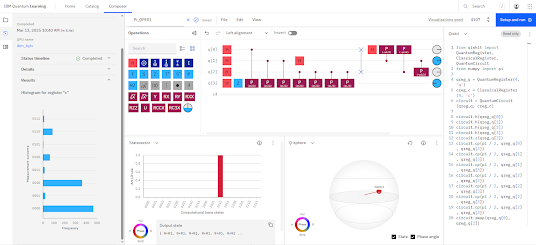Quantum advantage refers to the point at which quantum computers can solve problems—either faster or more efficiently—than the best classical computers available, and not merely in contrived or synthetic tasks but in areas with real-world relevance. Let’s dive deep into the core concepts, challenges, and implications of this phenomenon.
The Quantum Edge: How It Works
At the heart of quantum advantage lies the use of qubits instead of classical bits. Qubits can exist in a state of superposition, meaning they can represent both 0 and 1 simultaneously. This property, combined with entanglement—a phenomenon where qubits become interdependent regardless of distance—allows quantum computers to explore a vast computational space in parallel. While classical bits are binary, the state space of just a handful of qubits grows exponentially. This is the fundamental ingredient behind performing many calculations simultaneously in order to harness interference patterns that amplify the likelihood of correct answers and cancel out the rest.
Quantum algorithms are meticulously crafted to advantageously direct this behavior. For instance, Shor’s algorithm takes advantage of quantum parallelism to factor large integers exponentially faster than classical methods—a breakthrough with profound implications for cryptography. Similarly, quantum simulation algorithms can directly model the intricate behavior of particles in quantum chemistry, providing insights that are computationally prohibitive using classical approaches.
From Theory to Tangible Impact
A key element in achieving quantum advantage is not just the raw speed or parallelism but the meaningful transformation of how we tackle problems. Consider the following domains where quantum advantages might soon be realized:
Quantum Simulation: By modeling molecules and reactions with high precision, quantum simulation can revolutionize drug discovery and materials science. It promises to unravel the behavior of complex systems at an atomic level, potentially reducing years of experimental work to mere computational simulations.
Optimization: Many practical problems in logistics, scheduling, and finance are combinatorially complex. Algorithms like the Quantum Approximate Optimization Algorithm (QAOA) are designed to find near-optimal solutions in problems where classical methods would laboriously search through a maze of possibilities.
Machine Learning: Quantum machine learning algorithms leverage high-dimensional state representations, which can lead to more efficient processing of data-intensive tasks. The interplay between classical and quantum resources in hybrid models is expected to improve efficiencies in pattern recognition and data processing.
Cryptography and Security: While some quantum algorithms pose challenges—especially in terms of breaking certain encryption methods—they also foster the development of quantum-resilient cryptography and inherently secure techniques such as Quantum Key Distribution (QKD).
Technical Challenges on the Path
Despite its promise, realizing quantum advantage faces several hurdles:
Error Correction and Noise: Quantum systems are inherently fragile. Decoherence (the loss of quantum coherence) and operational errors can quickly negate the computational benefits a quantum computer might provide. Developing robust quantum error correction mechanisms is essential but remains one of the field’s most demanding challenges.
Algorithm Design: Not every problem will benefit from quantum approaches. Crafting algorithms that capitalize on quantum properties—while being resilient to errors and resource-efficient—requires careful and often novel design strategies. This means that for many real-world tasks, hybrid algorithms that combine the strengths of quantum and classical computing may be the most effective approach in the near term.
Resource Constraints: Many experimental systems currently operate in the so-called Noisy Intermediate-Scale Quantum (NISQ) era. These devices have a limited number of qubits and are prone to errors, which confines their immediate utility. Researchers are actively working on techniques such as error mitigation and novel circuit designs that can push these devices closer to practical quantum advantage.
Philosophical and Practical Implications
The journey toward quantum advantage isn’t merely about faster computations. It’s a paradigm shift in how we understand and interact with problems across science, engineering, and beyond. The very principles of quantum mechanics, once thought of as abstract and confined to physics laboratories, are now poised to impact diverse fields—from optimizing metropolitan traffic flows to discovering new pharmaceuticals. This transformation invites us to rethink computational limits and opens a doorway toward addressing previously intractable problems.
Moreover, the pursuit of quantum advantage challenges the established boundaries of classical computing. It propels discussions about computational complexity such as the class bounded-error quantum polynomial time (BQP), which comprises problems efficiently solvable by a quantum computer; and encourages a re-evaluation of what “efficient” computation truly means. As quantum technologies mature, they compel us to explore a dual narrative where quantum and classical paradigms coalesce, each complementing the other’s strengths.
Beyond the Horizon
While quantum advantage in controlled experiments might first manifest in niche, laboratory-specific problems, the downstream implications are vast. As research progresses:
Interdisciplinary collaborations will intensify, with quantum physicists, computer scientists, and industry experts working side by side to translate theoretical advancements into real-world applications.
Hybrid models blending quantum and classical computational strategies will likely become the standard, leveraging the best of both worlds.
As quantum processors scale up and error rates decrease, the types of applications that benefit from quantum acceleration will expand, perhaps even reaching everyday technologies.
In summary, quantum advantage represents a confluence of theoretical breaks, engineering milestones, and practical applications. It’s about fundamentally rethinking computation—trading off classical linearity for quantum complexity—and in doing so, opening the door to new realms of scientific and industrial possibility.
If you’re curious about how specific quantum algorithms—like the variational quantum eigensolver—are tailored to mitigate noise or how companies are planning the transition from NISQ devices to fault-tolerant quantum systems, we can delve even deeper into these areas. Alternatively, exploring the interplay between quantum error correction techniques and hardware design could reveal the nuances of making quantum advantage robust for practical tasks.
Suggested readings
- IBM Quantum - "What is Quantum Advantage?"
- Nature Review Article - "Quantum advantage and beyond"
- Google Quantum AI - "Quantum Computing Service"
- arXiv.org - "Quantum Advantage with Noisy Shallow Circuits"
- MIT Technology Review - "Quantum Computing"
- Quantum Computing Report
- McKinsey & Company - "Quantum computing use cases are getting real"
- NIST - "Quantum Computing and Post-Quantum Cryptography FAQs"
